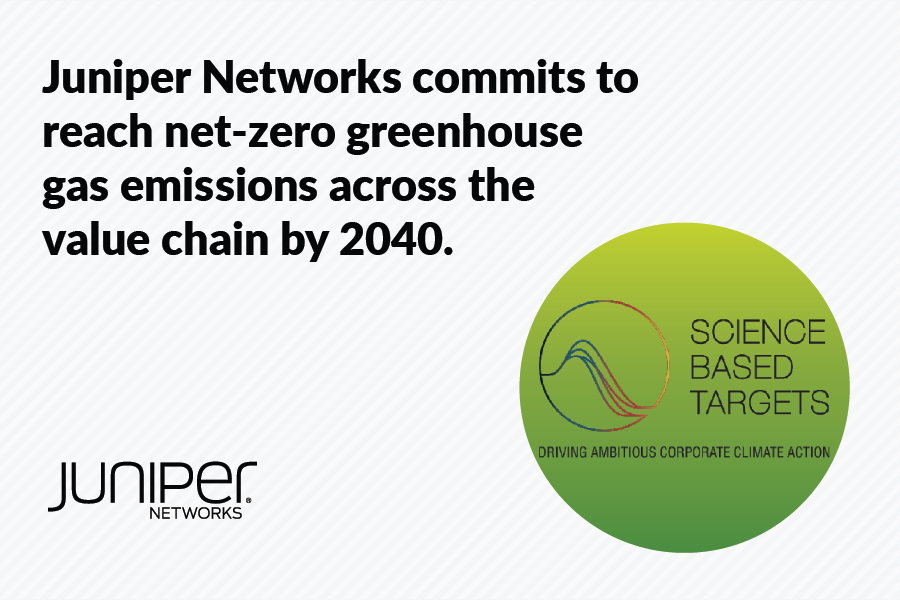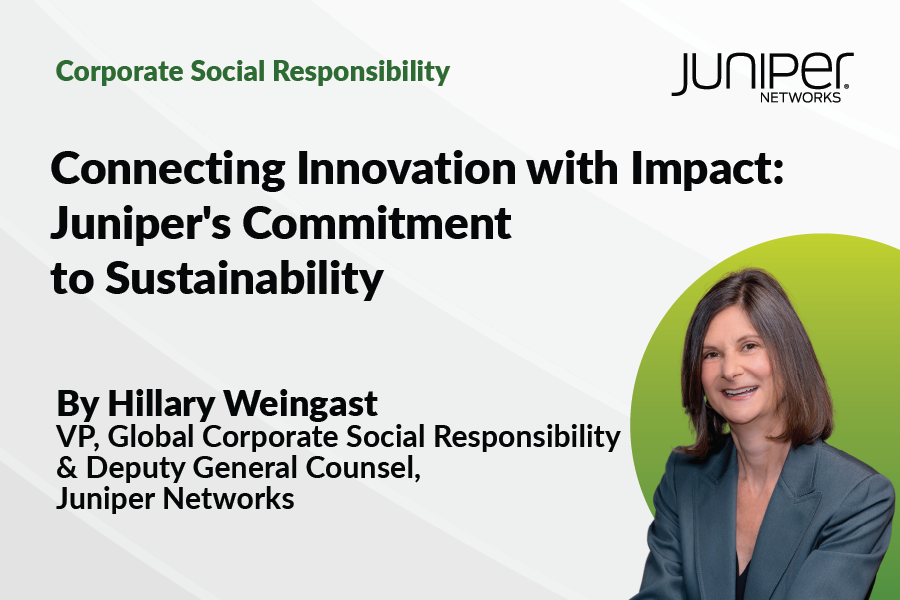At Juniper Networks, we are dedicated to proactively addressing climate change. We embody our mission to make every connection count in networking and the world around us. As a responsible global corporation, we’re committed to influencing positive, meaningful behavior that prioritizes the best interests of our customers, partners, employees, and, of course, the planet.
We know sustainability is a top priority for all our customers, which is reflected in the increasing inclusion of sustainability requirements for vendor-level environmental programs in networking RFPs and tenders. This global movement requires specific answers regarding how vendors are engineering out harmful materials, extending the life spans of systems and system components to reduce e-waste, reducing operational costs in the face of rising energy prices, and helping achieve internal sustainability initiatives.
Networking—including the devices that make up the WANs, data centers, and peering points that connect businesses to private networks, cloud, and service provider services—might seem like an unlikely place to start a conversation about enterprise sustainability. But sustainability isn’t just a trend. Customers are demanding it because they face regulatory requirements on carbon emissions, economic pressure, the soaring costs of power, and it’s simply the right thing to do. This makes reliable peering to service/cloud providers even more mission-critical and encourages a stronger focus on WAN technology as a strategic enabler of sustainable business value.
Juniper is strategically positioned to further extend our reputation for technical excellence with robust responses to sustainability challenges. Juniper has an advancing sustainability program represented by our sustainability strategic pillars—decarbonization, sustainable technologies, and circularity—designed to help accelerate the fulfillment of our own documented emissions reduction goals.
We have strategically invested in renewable energy via direct projects and power purchase agreements, which are long-term agreements for the purchase of renewable electricity. We have also demonstrated our commitment to delivering sustainable products to the market by investing in advanced low-power, high-performance ASICs and systems. Juniper’s multi-year advantage in artificial intelligence (AI) development and AI for IT operations (AIOps) is being extended to produce desirable outcomes in a range of power optimization use cases. For many customers, Juniper increasingly represents the opportunity to increase the value of their networks and address corporate initiatives, making Juniper not just a manufacturer of advanced products but also an innovative partner on the road to a more sustainable future.
The hybrid financial and sustainability benefits of a WAN technology refresh extend traditional total cost of ownership (TCO) studies to include the solution’s ability to:
- Act as a hedge against rising costs of power
- Extend life cycles from the current five to seven years to 12 to 15 years to help keep e-waste out of landfills
- Anticipate new applications and use cases by employing custom, programmable silicon for features that may not have even entered the standards bodies yet
- Harness the benefits of AIOps with products built to extract rich data and proven algorithms, producing valuable insight that can support building power and lighting to occupancy patterns, for example
- Include the software and port density flexibility to satisfy novel requirements in AI/ML-centric data center applications
Juniper’s silicon strategy has long been a differentiator, and we continue to execute it with industry breakthroughs in scale and throughput. Consider that the Express 5 ASIC is Juniper’s highest radix deep-buffer ASIC to date. It enables the construction of a wide range of 100G/400G/800G systems, with a 28.8T fixed-form factor PTX10002-36QDD routers to high-capacity petabit routing and switching platforms, all while providing more than twice the power efficiency gains compared with the previous generation.
The Junos® OS operating system continues to evolve to include power management capabilities in the WAN portfolio. Junos OS allows administrators to configure power priorities for line cards, manage power supply redundancy, and optimize power resources. The solution reduces power consumption through dynamic power management capabilities.
Paragon Automation – unique capabilities to optimize sustainability KPIs
Also, highly relevant to the topic of sustainability is Juniper’s Paragon Automation portfolio of network management capabilities, which distinguishes itself from other networking vendors with end-to-end intent-based lifecycle management that can optimize for KPIs including power efficiency, alongside customer experiences, service performance and network resilience.
First proposed by Juniper at Mobile World Congress 2024, power optimized routing is a key concept of power management in the WAN. Early results point to significant positive impacts on return on investment and TCO. Currently in development, power optimized routing is anticipated to be included in Juniper’s Paragon Automation offering in the near to medium term, and represents the clear potential for model-based, intent-based service orchestration in the WAN to incorporate power consumption as a network path optimization criterion.
Its standards-based, cloud-native microservices architecture allows it to move beyond traditional monitoring of devices to a far more complimentary model. This model intelligently combines device, network, and service key performance indicators (KPIs) through AI-enabled analytics to create onboarding, observability, management and trust standards that favor only necessary detail and focus on the actions necessary to maintain network health.
Paragon Automation sets Juniper and its customers on a path of scalable innovation, especially considering the powerful flywheel effect created by instrumenting Paragon with Juniper’s industry-leading AI capabilities. More data from more domains creates more learning, insights, and valuable actions for the network operator.
Juniper’s three pillars of sustainability
Underpinning the Juniper WAN portfolio is Juniper’s fundamental commitment to the three pillars of sustainability:
- Decarbonization: Juniper is committed to achieving net-zero emissions by 2040, including reducing supply chain emissions by 10% by 2025 and 25% by 2030. Juniper aims to accelerate a zero-carbon economy through meaningful emissions strategies throughout the entire value chain.
- Sustainable technology: Juniper is incorporating sustainability into the design and engineering of its products, emphasizing energy efficiency and more extended life cycle network architecture.
- Circularity: Juniper is working toward reducing and recycling waste while extending product life cycles by building products with end-of-life goals, enabling them to re-enter the supply chain rather than the landfill.
Juniper’s circular economy programs lead the industry. Our programs include:
- Juniper Try and Buy: Enables prospects to upgrade their network with a 60-90-day risk-free trial of Juniper’s latest technology
- Juniper Certified Pre-Owned Program (JCPO): Accepts excess or previously used products that are refurbished and tested for like-new performance and security
- Juniper Take Back Program: This program keeps hardware out of landfills and provides customers with certified asset disposal tracking and documentation to help them comply with regulatory targets. It maximizes the value of end-use products while minimizing environmental impact and recovering value from decommissioned or excess hardware.
Juniper’s commitment to climate improvement reinforces our sustainability strategy. Juniper has recently expanded its climate commitments with a short-term target and a long-term net-zero target by 2040, and our targets have been validated by the Science Based Targets initiative (SBTi). Juniper will follow a standards-based and highly quantifiable approach to continuing to reduce our carbon footprint.
Winning the Green Future Best Practice Award further validates Juniper’s sustainable technology credentials. Juniper was also recently awarded “Innovation/Game Changer” for the Power Steering innovation at the 2024 Telekom Campus Fair event in Bonn, Germany. This innovation can potentially improve the power efficiency of network infrastructure by up to 70% by monitoring traffic levels and dynamically aligning power needs with demand, optimizing resource utilization, and creating cost savings for network operators.
Juniper offers exceptional solutions essential to enlisting the WAN to fulfill organization-wide sustainability objectives successfully. Juniper’s AI-Native Networking Platform encompasses green power management and intelligent traffic control. It brings competitive advantages that are must-haves for cloud, operator, and enterprise decision-makers to prioritize in their selection and adoption processes.
Get the Futurum white paper here.
Get the Juniper Networks 2024 Corporate Social Responsibility Report here.
Join us for a Juniper Futurum sustainability webinar on October 8, 2024, at 11:00 a.m. ET. Register here. The webinar will be recorded and available at the same location.
Disclaimers
Juniper Networks, the Juniper Networks logo, Juniper, Junos, and other trademarks listed here are registered trademarks of Juniper Networks, Inc. and/or its affiliates in the United States and other countries. Other names may be trademarks of their respective owners.
Forward Looking Statements. This paper contains forward-looking statements within the meaning of the Private Securities Litigation Reform Act of 1995 regarding future events and the future results of Juniper Networks, Inc., that are based on our current expectations and which statements involve substantial risks and uncertainties. Except for historical information contained herein, all statements could be deemed forward-looking statements, including, without limitation, Juniper Networks’ views concerning our business, economic and market outlook; our current expectations with respect to industry and market trends; our product development; the strength of certain use-cases and customer segments; the introduction of future products; the strength of our solution portfolio; and overall future prospects.
Actual results or events could differ materially from those anticipated in those forward-looking statements as a result of several factors, including the factors listed in Juniper Networks’ most recent reports on Form 10-Q and 10-K filed with the Securities and Exchange Commission. These forward-looking statements are not guarantees of future performance and speak only as of the date of this paper. Juniper Networks undertakes no obligation to update the information in this paper in the event facts or circumstances subsequently change.
Statement of Product Direction. Juniper Networks may disclose information related to development and plans for future products, features, or enhancements, known as a Statement of Product Direction or Plan of Record (“POR”). These details provided are based on Juniper’s current development efforts and plans. These development efforts and plans are subject to change at Juniper’s sole discretion without notice. Except as may be set forth in a definitive agreement, Juniper Networks provides no assurances and assumes no responsibility to introduce products, features, or enhancements described in this website, presentation, meeting, or publication, nor is Juniper liable for any loss arising out of reliance on the POR. Purchasing decisions by third parties should not be based on this POR, and no purchases are contingent upon Juniper Networks delivering any feature or functionality described in this website, presentation, meeting, or publication.


